Paper Menu >>
Journal Menu >>
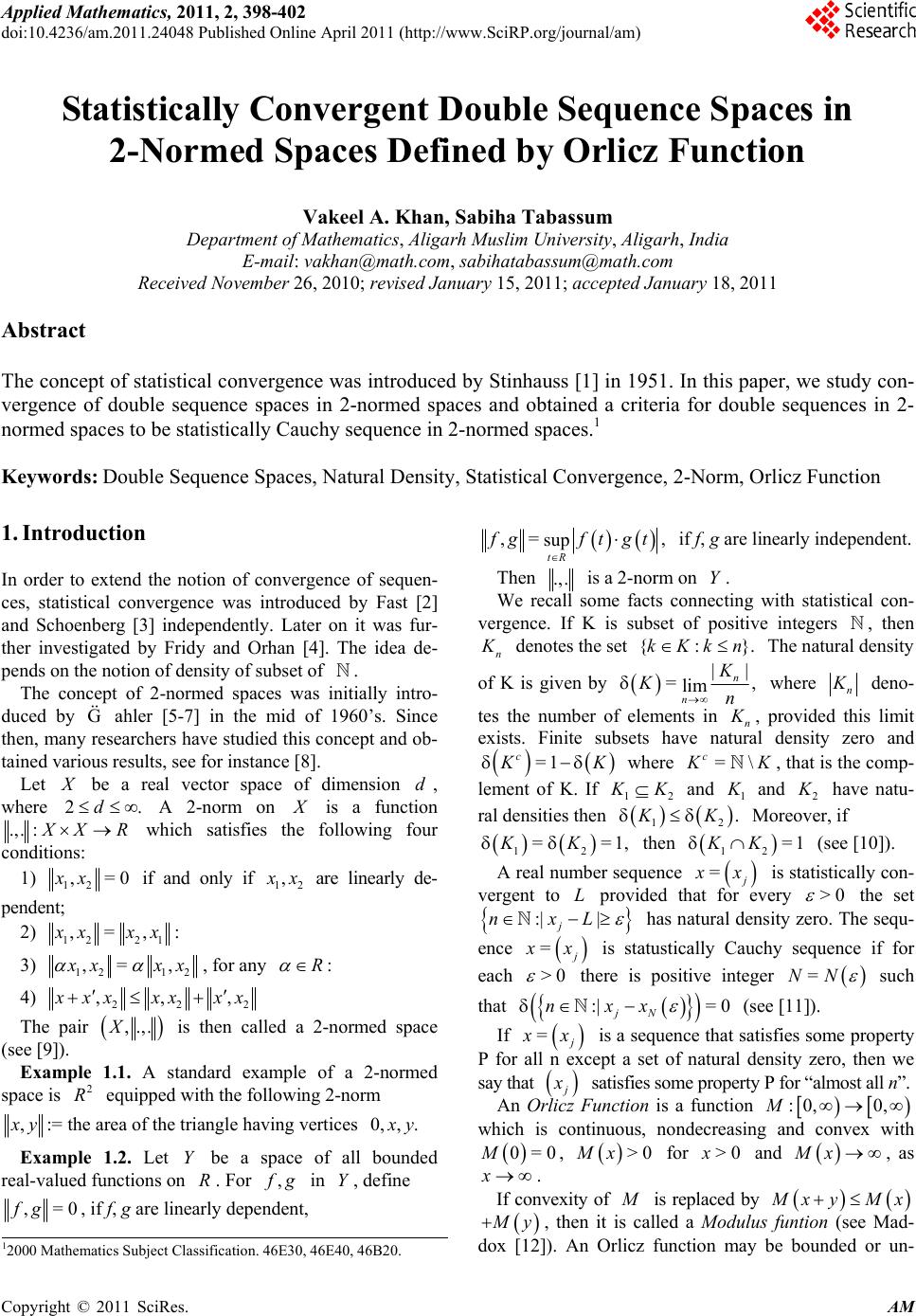 Applied Mathematics, 2011, 2, 398-402 doi:10.4236/am.2011.24048 Published Online April 2011 (http://www.SciRP.org/journal/am) Copyright © 2011 SciRes. AM Statistically Convergent Double Sequence Spaces in 2-Normed Spaces Defined by Orlicz Function Vakeel A. Khan, Sabiha Tabassum Department of Mat hematics, Aligarh Muslim University, Aligarh, India E-mail: vakhan@math.com, sabihatabassum@math.com Received November 26, 2010; revised January 15, 2011; accepted Ja nu ary 18, 2011 Abstract The concept of statistical convergence was introduced by Stinhauss [1] in 1951. In this paper, we study con- vergence of double sequence spaces in 2-normed spaces and obtained a criteria for double sequences in 2- normed spaces to be statistically Cauchy sequence in 2-normed spaces.1 Keywords: Double Sequence Spaces, Natural Density, Statistical Convergence, 2-Norm, Orlicz Function 1. Introduction In order to extend the notion of convergence of sequen- ces, statistical convergence was introduced by Fast [2] and Schoenberg [3] independently. Later on it was fur- ther investigated by Fridy and Orhan [4]. The idea de- pends on the notion of density of subset of . The concept of 2-normed spaces was initially intro- duced by G ahler [5-7] in the mid of 1960’s. Since then, many researchers have studied this concept and ob- tained various results, see for instance [8]. Let X be a real vector space of dimension d, where 2.d A 2-norm on X is a function .,. : X XR which satisfies the following four conditions: 1) 12 ,=0xx if and only if 12 , x x are linearly de- pendent; 2) 12 21 ,=, x xxx: 3) 12 12 ,= , x xxx , for any R : 4) 22 2 ,,, x xxxx xx The pair ,.,.X is then called a 2-normed space (see [9]). Example 1.1. A standard example of a 2-normed space is 2 R equipped wit h t he f oll owing 2-norm ,:=xy the area of the triangle having vertices 0,,. x y Example 1.2. Let Y be a space of all bounded real-valued functions on R. For , f g in Y, define ,=0fg , if f, g are linearly dependent, , =, sup tR f gftgt if f, g are linearly independent. Then .,. is a 2-norm on Y. We recall some facts connecting with statistical con- vergence. If K is subset of positive integers , then n K denotes the set {:}.kKkn The natural density of K is given by || =, lim n n K Kn where n K deno- tes the number of elements in n K , provided this limit exists. Finite subsets have natural density zero and =1 c K K where =\ c K K, that is the comp- lement of K. If 12 K K and 1 K and 2 K have natu- ral densities then 12 .KK Moreover, if 12 ==1,KK then 12 =1KK (see [10]). A real number sequence = j x x is statistically con- vergent to L provided that for every >0 the set :| | j nxL has natural density zero. The sequ- ence = j x x is statustically Cauchy sequence if for each >0 there is positive integer =NN such that :|= 0 jN nxx (see [11]). If = j x x is a sequence that satisfies some property P for all n except a set of natural density zero, then we say that j x satisfies some property P for “almost all n”. An Orlicz Function is a function :0, 0,M which is continuous, nondecreasing and convex with 0=0M, >0Mx for >0x and Mx, as x . If convexity of M is replaced by M xy Mx M y, then it is called a Modulus funtion (see Mad- dox [12]). An Orlicz function may be bounded or un- 12000 Mathematics Subject Classification. 46E30, 46E40, 46B20. 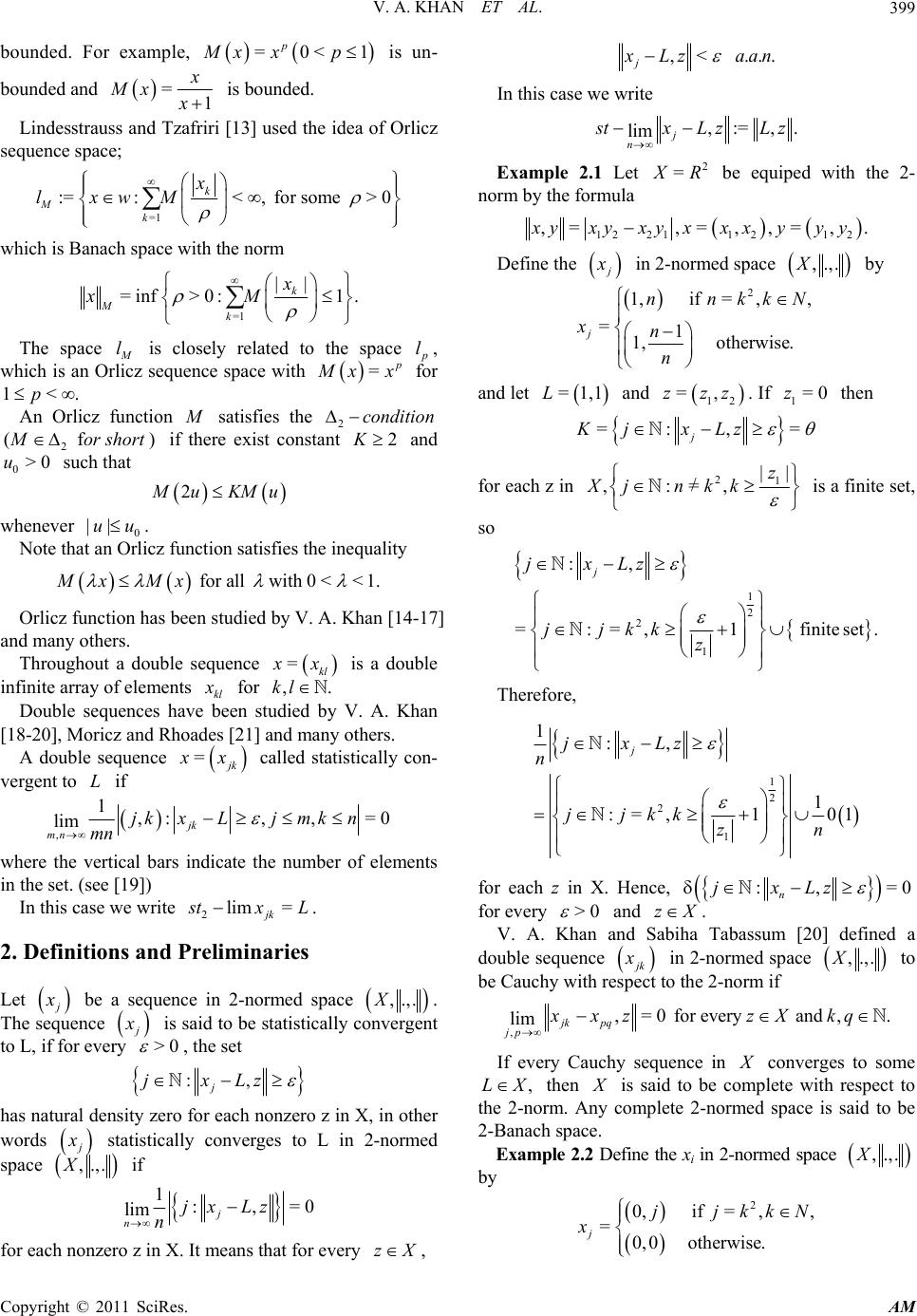 V. A. KHAN ET AL. Copyright © 2011 SciRes. AM 399 bounded. For example, =0<1 p Mx xp is un- bounded and =1 x Mx x is bounded. Lindesstrauss and Tzafriri [13] used the idea of Orlicz sequence space; =1 :=:<, for some >0 k Mk x lxwM which is Banach space with the norm =1 || =inf>0:1 . k Mk x xM The space M l is closely related to the space p l, which is an Orlicz sequence space with = p M xx for 1<.p An Orlicz function M satisfies the 2condition 2 ( f ) M or short if there exist constant 2K and 0>0u such that 2 M uKMu whenever 0 ||uu. Note that an Orlicz function satisfies the inequality for all with 0<<1.Mx Mx Orlicz function has been studied by V. A. Khan [14-17] and many others. Throughout a double sequence =kl x x is a double infinite array of elements kl x for ,.kl Double sequences have been studied by V. A. Khan [18-20], Moricz and Rhoades [21] and many others. A double sequence = j k x x called statistically con- vergent to L if , 1,:, ,=0 lim jk mn jkxLj mk n mn where the vertical bars indicate the number of elements in the set. (see [19]) In this case we write 2lim = jk s txL. 2. Definitions and Preliminaries Let j x be a sequence in 2-normed space ,.,.X. The sequence j x is said to be statistically convergent to L, if for every >0 , the set :, j jxLz has natural density zero for each nonzero z in X, in other words j x statistically converges to L in 2-normed space ,.,.X if 1:,=0 lim j njx Lz n for each nonzero z in X. It means that for every zX , ,< ... j x Lz aan In this case we write ,:=,. lim j n s tx LzLz Example 2.1 Let 2 = X R be equiped with the 2- norm by the formula 12211 21 2 ,=,= ,,=,. x yxyxyxxxyyy Define the j x in 2-normed space ,.,.X by 2 1, if =,, = 1 1, otherwise. j nnkkN xn n and let =1,1L and 12 =,zzz. If 1=0z then =:,= j Kj xLz for each z in 21 || ,:=, z Xj nkk is a finite set, so 1 2 2 1 :, =:=,1 finite set. j jxLz jjkk z Therefore, 1 2 2 1 1:, 1 := ,101 j jxLz n jjkk zn for each z in X. Hence, :, =0 n jxLz for every >0 and zX . V. A. Khan and Sabiha Tabassum [20] defined a double sequence j k x in 2-nor med space ,.,.X to be Cauchy with respect to the 2-norm if ,,=0for every and ,. lim jk pq jp xxzzX kq If every Cauchy sequence in X converges to some ,LX then X is said to be complete with respect to the 2-norm. Any complete 2-normed space is said to be 2-Banach space. Example 2.2 Define the xi in 2-normed space ,.,.X by 2 0, if =,, =0,0 otherwise. j jjkkN x 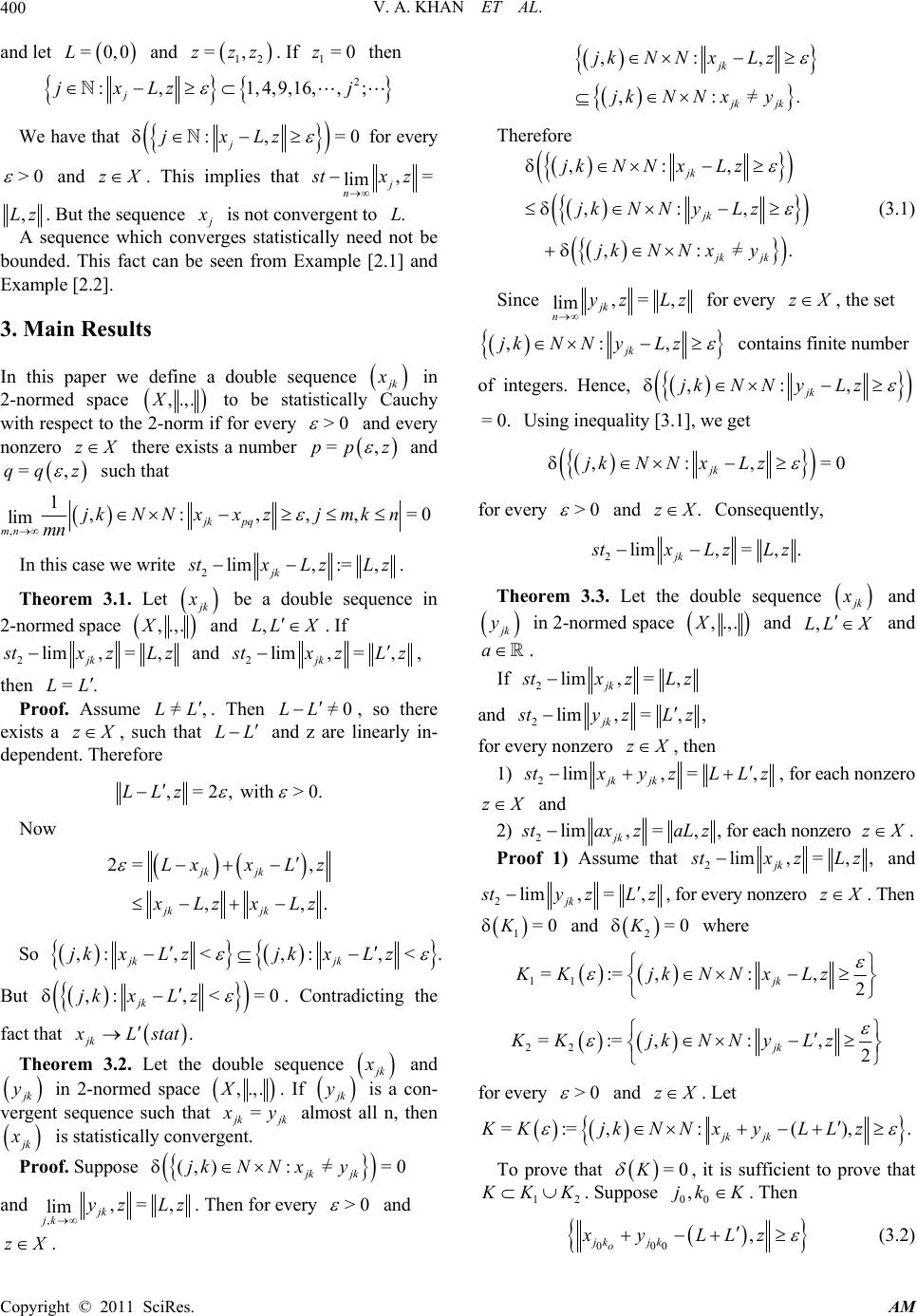 V. A. KHAN ET AL. Copyright © 2011 SciRes. AM 400 and let =0,0L and 12 =,zzz. If 1=0z then 2 :,1,4,9,16, , ; j jxLzj We have that :, =0 j jxLz for every >0 and zX. This implies that ,= lim j n s txz ,Lz. But the sequence j x is not convergent to .L A sequence which converges statistically need not be bounded. This fact can be seen from Example [2.1] and Example [2.2]. 3. Main Results In this paper we define a double sequence j k x in 2-normed space ,.,.X to be statistically Cauchy with respect to the 2-norm if for ever y >0 and every nonzero zX there exists a number =,pp z and =,qqz such that , 1,:,,,=0 lim jk pq mn jkNNxxzjmkn mn In this case we write 2lim, :=, jk s tx LzLz . Theorem 3.1. Let j k x be a double sequence in 2-normed space ,.,.X and ,LL X . If 2lim, = , jk s txzLz and 2lim, =, jk s txzLz , then =.LL Proof. Assume =,LL . Then =0LL , so there exists a zX, such that LL and z are linearly in- dependent. Therefore ,=2, with >0.LLz Now 2= , ,,. jk jk jk jk LxxL z x LzxLz So ,: ,<,: ,< jk jk jkxL zjkxL z . But ,:,<=0 jk jkxL z . Contradicting the fact that . jk x Lstat Theorem 3.2. Let the double sequence j k x and j k y in 2-normed space ,.,.X. If j k y is a con- vergent sequence such that = j kjk x y almost all n, then j k x is statistically convergent. Proof. Suppose (,): ==0 jk jk jkNN xy and ,,=, lim jk jk yz Lz . Then for every >0 and zX. ,:, ,:=. jk jk jk jkN NxLz jkNNxy Therefore ,:, ,:, ,:=. jk jk jk jk jkN NxLz jkN NyLz jkNNxy (3.1) Since ,=, lim jk nyzLz for every zX, the set ,:, jk jkN NyLz contains finite number of integers. Hence, ,:, jk jkN NyLz =0. Using inequality [3.1], we get ,:,=0 jk jkN NxLz for every >0 and .zX Consequently, 2lim,=, . jk s tx LzLz Theorem 3.3. Let the double sequence j k x and j k y in 2-normed space ,.,.X and ,LL X and a . If 2lim, = , jk s txzLz and 2lim,=, , jk s tyzLz for every nonzero zX , then 1) 2lim, =, jk jk s txyzLLz , for each nonzero zX and 2) 2lim, =, jk s taxzaLz, for each nonzero zX . Proof 1) Assume that 2lim,=, , jk s txzLz and 2lim, =, jk s tyzLz , for every nonzero zX . Then 1=0K and 2=0K where 11 =:=,: , 2 jk KKjkNNx Lz 22 =:=,: , 2 jk KK jkNNyLz for every >0 and zX . Let =:=,:(), . jk jk KKjk NNxyLLz To prove that =0K , it is sufficient to prove that 12 K KK. Suppose 00 ,jk K. Then 000, jk jk o xy LLz (3.2) 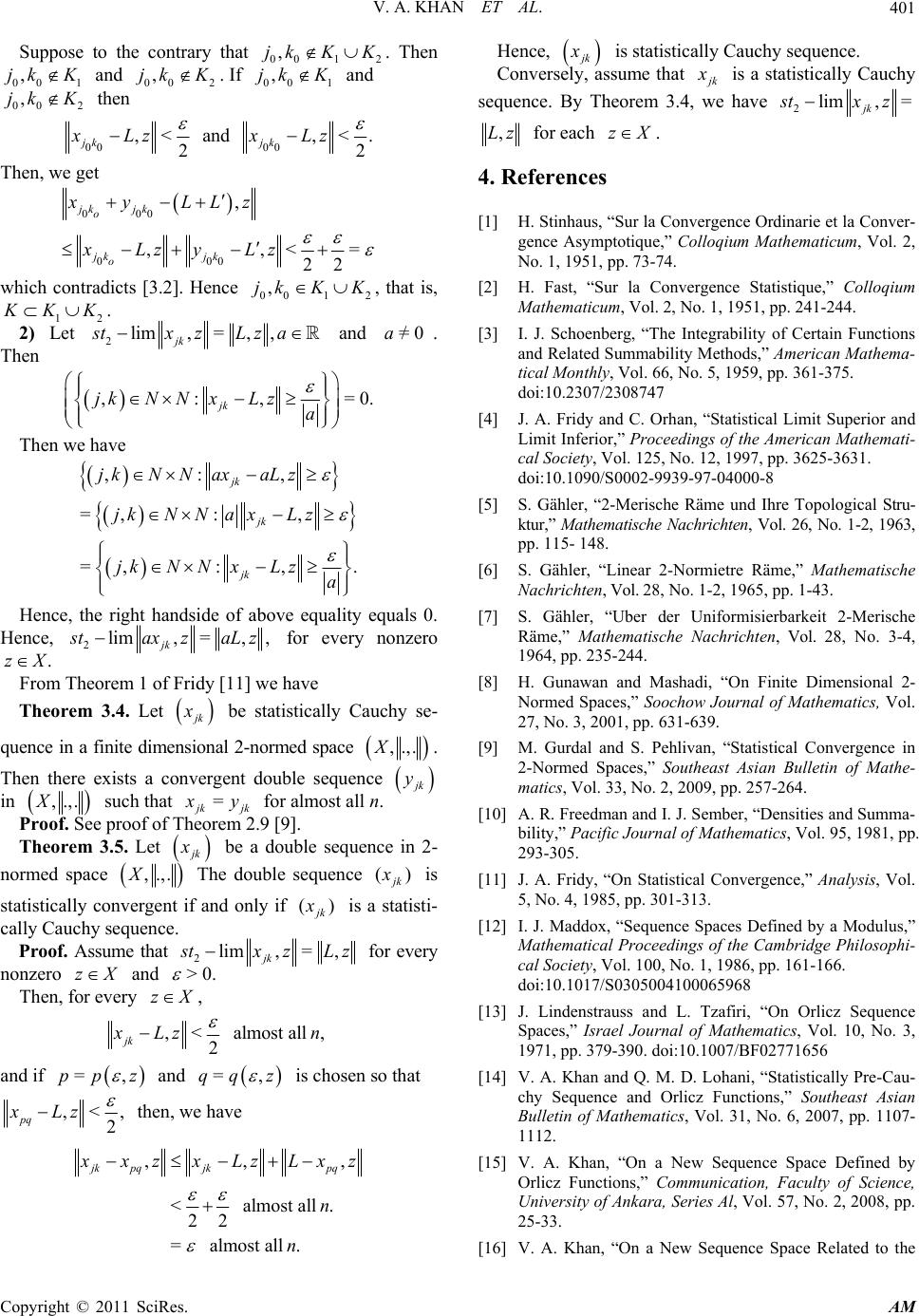 V. A. KHAN ET AL. Copyright © 2011 SciRes. AM 401 Suppose to the contrary that 00 12 ,jk K K. Then 00 1 ,jk K and 002 ,jkK. If 001 ,jk K and 00 2 ,jk K then 00 ,< 2 jk xLz and 00,<. 2 jk xLz Then, we get 000 000 , ,, <= 22 jk jk o jk jk o xy LLz xLzyLz which contradicts [3.2]. Hence 0012 ,jk K K, that is, 12 K KK. 2) Let 2lim,=, , jk stxzL za and =0a. Then ,:,=0. jk jkN NxLza Then we have ,:, =,: , =,: ,. jk jk jk jkN NaxaLz jkNNa xLz jkN NxLza Hence, the right handside of above equality equals 0. Hence, 2lim,=,, jk s taxzaLz for every nonzero .zX From Theorem 1 of Fridy [11] we have Theorem 3.4. Let j k x be statistically Cauchy se- quence in a finite dimensional 2-normed space ,.,.X. Then there exists a convergent double sequence j k y in ,.,.X such that = j kjk x y for almost all n. Proof. See proof of Theorem 2.9 [9]. Theorem 3.5. Let j k x be a double sequence in 2- normed space ,.,.X The double sequence () j k x is statistically convergent if and only if () j k x is a statisti- cally Cauchy sequence. Proof. Assume that 2lim, = , jk s txzLz for every nonzero zX and >0. Then, for every zX, ,< almost all , 2 jk x Lz n and if =,pp z and =,qq z is chosen so that ,<, 2 pq xLz then, we have ,,, < almost all . 22 = almost all . jk pqjkpq x xzxLz Lxz n n Hence, j k x is statistically Cauchy sequence. Conversely, assume that j k x is a statistically Cauchy sequence. By Theorem 3.4, we have 2lim, = jk s txz ,Lz for each zX . 4. References [1] H. Stinhaus, “Sur la Convergence Ordinarie et la Conver- gence Asymptotique,” Colloqium Mathematicum, Vol. 2, No. 1, 1951, pp. 73-74. [2] H. Fast, “Sur la Convergence Statistique,” Colloqium Mathematicum, Vol. 2, No. 1, 1951, pp. 241-244. [3] I. J. Schoenberg, “The Integrability of Certain Functions and Related Summability Methods,” American Mathema- tical Monthly, Vol. 66, No. 5, 1959, pp. 361-375. doi:10.2307/2308747 [4] J. A. Fridy and C. Orhan, “Statistical Limit Superior and Limit Inferior,” Proceedings of the American Mathemati- cal Society, Vol. 125, No. 12, 1997, pp. 3625-3631. doi:10.1090/S0002-9939-97-04000-8 [5] S. Gähler, “2-Merische Räme und Ihre Topological Stru- ktur,” Mathematische Nachrichten, Vol. 26, No. 1-2, 1963, pp. 115- 148. [6] S. Gähler, “Linear 2-Normietre Räme,” Mathematische Nachrichten, Vol. 28, No. 1-2, 1965, pp. 1-43. [7] S. Gähler, “Uber der Uniformisierbarkeit 2-Merische Räme,” Mathematische Nachrichten, Vol. 28, No. 3-4, 1964, pp. 235-244. [8] H. Gunawan and Mashadi, “On Finite Dimensional 2- Normed Spaces,” Soochow Journal of Mathematics, Vol. 27, No. 3, 2001, pp. 631-639. [9] M. Gurdal and S. Pehlivan, “Statistical Convergence in 2-Normed Spaces,” Southeast Asian Bulletin of Mathe- matics, Vol. 33, No. 2, 2009, pp. 257-264. [10] A. R. Freedman and I. J. Sember, “Densities and Summa- bility,” Pacific Journal of Mathematics, Vol. 95, 1981, pp. 293-305. [11] J. A. Fridy, “On Statistical Convergence,” Analysis, Vol. 5, No. 4, 1985, pp. 301-313. [12] I. J. Maddox, “Sequence Spaces Defined by a Modulus,” Mathematical Proceedings of the Cambridge Philosophi- cal Society, Vol. 100, No. 1, 1986, pp. 161-166. doi:10.1017/S0305004100065968 [13] J. Lindenstrauss and L. Tzafiri, “On Orlicz Sequence Spaces,” Israel Journal of Mathematics, Vol. 10, No. 3, 1971, pp. 379-390. doi:10.1007/BF02771656 [14] V. A. Khan and Q. M. D. Lohani, “Statistically Pre-Cau- chy Sequence and Orlicz Functions,” Southeast Asian Bulletin of Mathematics, Vol. 31, No. 6, 2007, pp. 1107- 1112. [15] V. A. Khan, “On a New Sequence Space Defined by Orlicz Functions,” Communication, Faculty of Science, University of Ankara, Series Al, Vol. 57, No. 2, 2008, pp. 25-33. [16] V. A. Khan, “On a New Sequence Space Related to the 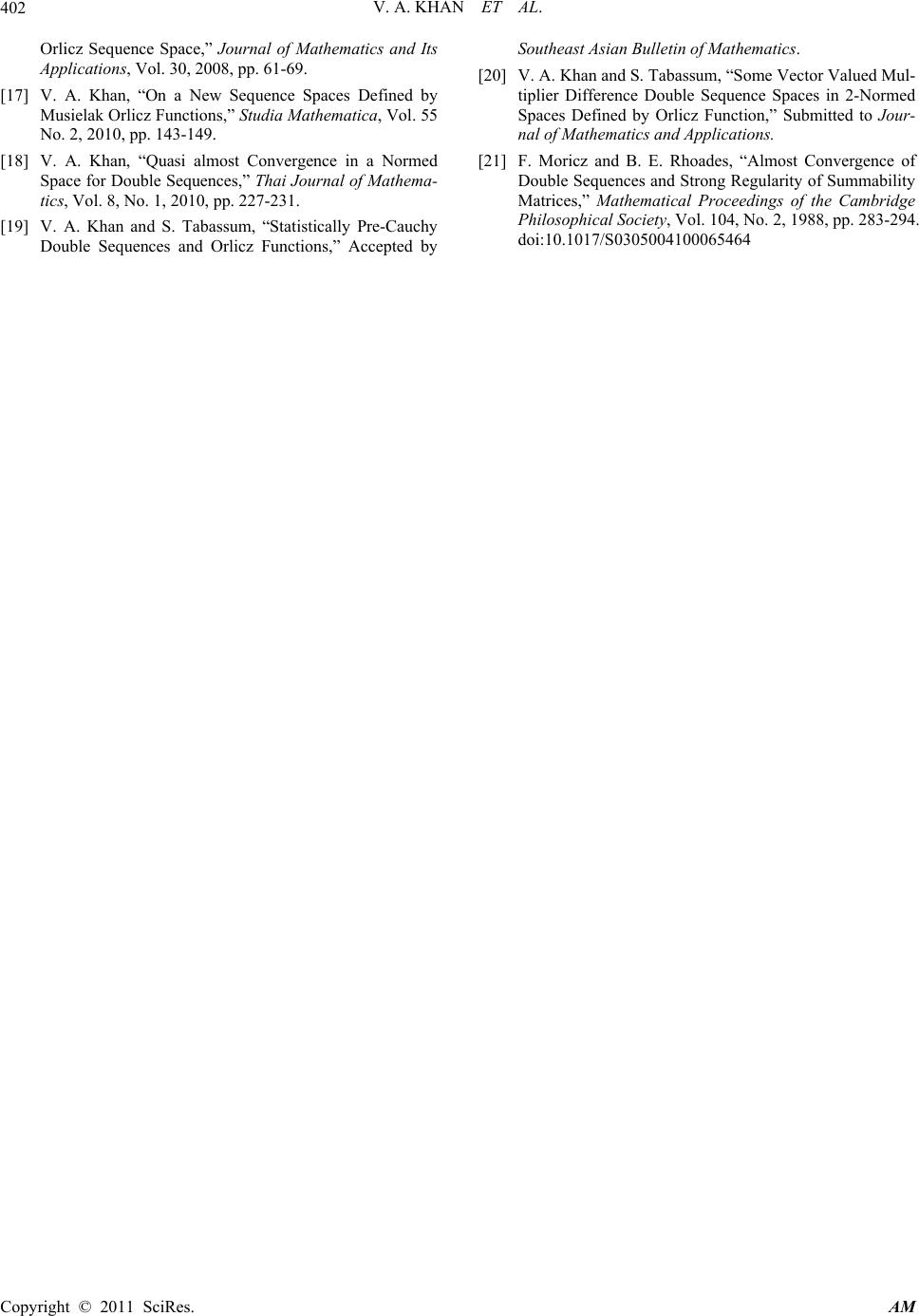 V. A. KHAN ET AL. Copyright © 2011 SciRes. AM 402 Orlicz Sequence Space,” Journal of Mathematics and Its Applications, Vol. 30, 2008, pp. 61-69. [17] V. A. Khan, “On a New Sequence Spaces Defined by Musielak Orlicz Functions,” Studia Mathematica, Vol. 55 No. 2, 2010, pp. 143-149. [18] V. A. Khan, “Quasi almost Convergence in a Normed Space for Double Sequences,” Thai Journal of Mathema- tics, Vol. 8, No. 1, 2010, pp. 227-231. [19] V. A. Khan and S. Tabassum, “Statistically Pre-Cauchy Double Sequences and Orlicz Functions,” Accepted by Southeast Asian Bulletin of Mathema tics. [20] V. A. Khan and S. Tabassum, “Some Vector Valued Mul- tiplier Difference Double Sequence Spaces in 2-Normed Spaces Defined by Orlicz Function,” Submitted to Jour- nal of Mathematics and Applications. [21] F. Moricz and B. E. Rhoades, “Almost Convergence of Double Sequences and Strong Regularity of Summability Matrices,” Mathematical Proceedings of the Cambridge Philosophical Society, Vol. 104, No. 2, 1988, pp. 283-294. doi:10.1017/S0305004100065464 |

